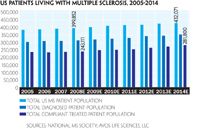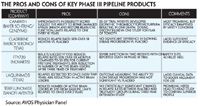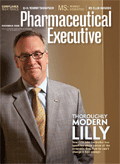The Mess in MS
A five-year forecast of the multiple-sclerosis market following the disruptions of Tysabri
Patients suffering from multiple sclerosis (MS) have seen their fair share of broken medical promises in recent years. Back in 2003, biopharma was on a roll, making reassuring strides in the treatment of this chronic, progressive autoimmune disorder. In the previous decade, FDA had approved five disease-modifying drugs—where previously there had been none. The future was looking even brighter, with combination therapies, oral treatments, and a powerful first-in-class monoclonal antibody (MAb) named Tysabri coming out of the pipeline.
But the last five years have largely been a bust. Serious setbacks dampened the optimism of the 400,000 people living with MS in the US, and the 2.5 million diagnosed worldwide (see "US Patients Living With MS, 2005–2014"). The category is overdue for an infusion of innovative new products. Fortunately, according to recent AVOS Life Sciences research ("Multiple Sclerosis Agents: US Market Outlook") into the clinical and commercial dynamics that will shape the MS market through 2015, patients and their doctors can expect significant change in the form of new treatment options—largely as a result of the introduction of oral agents to a traditionally biological therapeutic category. Still, a strong sense of uncertainty permeates this medically challenging disease.
The Troubles of Tysabri
Biogen Idec's Tysabri (natalizumab) has been the decade's big spoiler in MS. Launched in 2004 after FDA fast-tracking, the MAb was poised to disrupt the market in the best sense: It showed unprecedented efficacy in reducing the frequency of relapses suffered by MS patients. Then as now, the MS segment is characterized by biologics that require daily or weekly self-administered injections. In contrast, Tysabri offered a novel mechanism of action, less frequent dosing, fewer side effects, and greater potency than standard therapies. The drug was widely predicted to be the next gold standard in MS treatment and a sure-fire blockbuster.
Instead, Biogen Idec was forced to yank Tysabri from the market in February 2005 after three former trial participants developed progressive multifocal leukoencephalopathy (PML), a serious brain infection; two of them died. Yet under pressure from MS patients, Tysabri made an unexpected comeback in 2006 under an FDA-approved restricted access program, on the basis that the drug's benefits outweighed the risk of developing PML.

US PATIENTS LIVING WITH MULTIPLE SCLEROSIS, 205-2014
That claim is currently being tested. Biogen Idec disclosed the occurrence of two new cases of PML last July, the first since the drug's reintroduction. But given a worldwide Tysabri patient population of more than 31,000, two new cases of PML may mean that the danger of developing the brain infection while on the drug is actually lower than the previously estimated risk of 1 in 1,000 (0.1 percent). Researchers are still seeking to understand why PML occurs, what co-factors encourage PML to develop in Tysabri patients, and how to further mitigate the PML risk. But barring a breakthrough, the drug's black-box warning has dimmed its initial promise as a major treatment advance. Still, Tysabri does offer increased efficacy and quality of life, and for that reason it's likely to remain on the market. In the worst-case scenario, it will have flattened sales and end up filling a niche for patients who have failed first line treatments.
A Cautious Turn Among Doctors
In the wake of the Tysabri-related PML deaths, physicians have developed not only a much more conservative approach to prescribing, but also a heightened sensitivity to safety and tolerability in general and a greater appreciation of the true potency of MS drugs.
The current MS market looks more or less like it did three years ago when Tysabri arrived on the scene. The beta interferon class, consisting of Biogen Idec's Avonex, Bayer Schering's Betaseron, and Merck Serono's Rebif, remains dominant, accounting for 69 percent of prescriptions written in the US in 2007. Avonex leads with a little more than a third of market share. Not far behind is Teva's Copaxone (glatiramer acetate), a polypeptide therapy that was introduced at almost the same time as Avonex in 1996, and that meets the need for a non-interferon treatment absent neutralizing antibodies and flulike symptoms. Copaxone has long been the market's No. 2 drug, its growth hindered by the need for daily self-injections.
The Tysabri clinical trials demonstrated the risks of using this disease-modifying MS agent, especially in combination with beta-interferons. What had been a growing sense of confidence in the first-generation biologicals—which went so far as to compel the drugmakers to launch dual-therapy Tysabri/Avonex trials during the MAb's clinical development—was shaken when two of the three cases of PML emerged from those trials. Combination therapy is no longer recommended.
Neurologists are also increasingly wary of switching a patient from a drug that has proved effective to a new treatment that may offer greater efficacy, but may also expose them to a new set of side effects. Doctors are demanding more extensive, longer term clinical data before endorsing a new MS drug on a broad basis. This orientation—call it the Tysabri effect—will likely slow the uptake of the new oral MS drugs as well.
Holding Tysabri back is the physicians' understandable fear that the drug may be too "heavy-handed" for the majority of patients, who have on-ly mild-to-moderate relapse-remitting MS. (Those using Tysabri, and the ones who cried loudest for its return to the market, had more aggressive or advanced stages of the disease generally beyond the reach of the beta interferons.) Tysabri's market share is likely to reach 5 percent this year, despite the new PML scare; the MAb will gain traction through 2014, while the beta interferons slowly decline as they are bested by new treatment options (see "Future Market Trends for Current Products, 2007–2014").
The Pipeline and Its Promises
Several late-stage oral drugs and a novel biological are poised to usher in a new, improved treatment regimen in MS—or at least promise to. A plethora of pharmas and biotechs are working to develop the next disruptive MS therapy: an oral medication. This big leap in convenience will drive a value shift in the segment as patients also seek incremental efficacy from these new mechanisms.

FUTURE MARKET TRENDS FOR CURRENT PRODUCTS, 2007-2014
Development delays and failures have made the expectation of an oral MS drug old news for almost a decade. In 2005, Merck Serono/Teva's cladribine and Sanofi-Aventis' teriflunomide were two oral drugs on track to launch in 2008. Since that analysis, Teva's oral formulation of the injectable Copaxone got derailed, while cladribine and teriflunomide remain in clinical trials with filings now targeted for 2009 and 2012, respectively, according to company estimates. But recent positive trial outcomes suggest that one or more oral formulations may finally reach the market by 2014. The most promising, in addition to cladribine and teriflunomide, are Teva's laquinimod and Novartis' FTY720. All are late-stage compounds that use a unique mechanism of action to achieve reductions in relapse rates, in new lesion formation in the brain, and in the risk of disability progression.
Meanwhile, Bayer Schering and Genzyme are co-developing Campath (alemtuzumab), a biologic similar to Tysabri. Industry buzz about the drug centers on Campath's potential for short, intermittent doses to put MS into remission for a period ranging from five to 20 years. If such claims are valid, Campath will represent a milestone in the treatment of MS. On track for a 2013 launch, the MAb, which must be infused, is likely to enter a crowded MS market of orally administered competitors.
Even with the MS market's many unmet needs, novel treatments will increasingly be required to meet higher standards of safety and prove their value before they can gain wide market acceptance (see "Key Phase III Pipeline Products").
Comparing the Meds, Valuing the Market
The success of next-generation MS drugs will be based chiefly on their mechanism of action—and efficacy—with oral delivery a secondary feature. Interviews by AVOS with a diverse set of MS specialists revealed that they were split in their prioritizing of ease of administration. Some physicians indicated that they and their patients are eager to obtain the first oral MS therapy and abandon injections, while other physicians expressed wariness about sacrificing stability and slowed disease progression for the sake of dosing convenience. Weaker efficacy will not be tolerated; oral treatments must prove at least as effective and safe as the beta-interferons to gain any credibility.

THE PROS AND CONS OF KEY PHASE III PIPELINE PRODUCTS
The oral medications are likely to be adopted initially as second or even third line treatment options. They will have to prove their utility and value in patients for whom other drugs have failed before moving to first line status. Physicians reported that they would handle patient requests to switch from injectables to orals on a case-by-case basis, but generally were not inclined to switch stable patients before long term data and usage are available—a dynamic already evidenced in the prescribing pattern of Tysabri.
Which compounds in the MS pipeline will deliver on their promise over the next seven years? What specific criteria will determine their success? To answer these questions, AVOS examined efficacy, safety, and administration data from the most recent clinical trials for five late-stage candidates with unique mechanisms of action, comparing the attributes to those of Avonex, the market leader and benchmark. The analysis determined that Bayer's Campath, Sanofi-Aventis' teriflunomide, and Novartis' FTY720 appear to be superior to Avonex, while Merck Serono/Teva's cladribine and Teva's laquinimod fell below the benchmark. Both Campath and FTY720 displayed better efficacy, but were marred by severe safety concerns, which are likely to require additional trials and delay their launch. The three other drugs, all orals, demonstrate weaker efficacy than that of Campath or FTY720, but fared better on administration and safety.

US DRUG MARKET MS DRUG REVENUE BY CLASS (IN THOUSANDS)
These new therapies will increase overall MS market growth through 2014. AVOS estimates that total revenues in the US will jump from $3.9 billion in 2008 to $5.9 billion in 2014. The worldwide market, largely identical in product offerings, will experience 67 percent revenue growth over the same period—split evenly between the US and other high-prevalence areas such as Europe and Canada. The global MS market value in 2014 is estimated to be about $10 billion (see "US Market's MS Drug Revenue by Class").
Interestingly, no precedent exists by which to predict how a market characterized solely by injectable biologics will react when oral pills are first introduced. The convenience of a pill is not sufficient incentive for oral therapies to change the therapeutic market overnight, the way the arrival of generics treatments do. Pricing power will also resist any massive reductions associated with the introduction of oral drugs. As long as doctors view oral formulation attributes as secondary when making a prescribing decision, an oral's ability to be priced at a premium and garner higher reimbursement rates will be dependent upon a superior clinical profile. Tysabri's significant price premium ($27,000 a year) reflects the drug's better efficacy. Convenience alone will not be the key determining factor in awarding price premiums or discounts.
Yet it's important to remember that the success rate of bringing new MS treatments to market is poor. Only 5 percent of all MS compounds that entered clinical trials in 1995 or later won FDA approval—that's significantly less than the industry average of 12 percent. And the agency's increasingly conservative safety approach may not bode well for drugs like FTY720 and Campath that have already displayed questionable safety records marred by patient deaths in trials.
Multiple sclerosis remains a poorly understood disease. While its mechanisms are increasingly identified, yielding more advanced disease-modifying agents, the causal question (Why does the body's immune system start attacking the brain's myelin sheath in the first place?) continues to baffle researchers. On the bright side, the field is well funded, and the sheer volume of MS products in the pipeline (14 in Phase III and 18 in Phase II) is a strong signal that at least one new product will enter the market by 2014. Further delays, setbacks, and disappointments are inevitable, though, and the next significant treatment breakthrough in MS is still waiting to be found.
Jim Wahl is an associate at AVOS Life Sciences, a management consultancy and research products firm in Research Triangle Park, NC. He can be reached at jwahl@avoslifesciences.com. Requests for copies of AVOS's MS Therapeutic Market Outlook report can be e-mailed to reports@avoslifesciences.com
The Misinformation Maze: Navigating Public Health in the Digital Age
March 11th 2025Jennifer Butler, chief commercial officer of Pleio, discusses misinformation's threat to public health, where patients are turning for trustworthy health information, the industry's pivot to peer-to-patient strategies to educate patients, and more.
Navigating Distrust: Pharma in the Age of Social Media
February 18th 2025Ian Baer, Founder and CEO of Sooth, discusses how the growing distrust in social media will impact industry marketing strategies and the relationships between pharmaceutical companies and the patients they aim to serve. He also explains dark social, how to combat misinformation, closing the trust gap, and more.
